Page 31 of 395
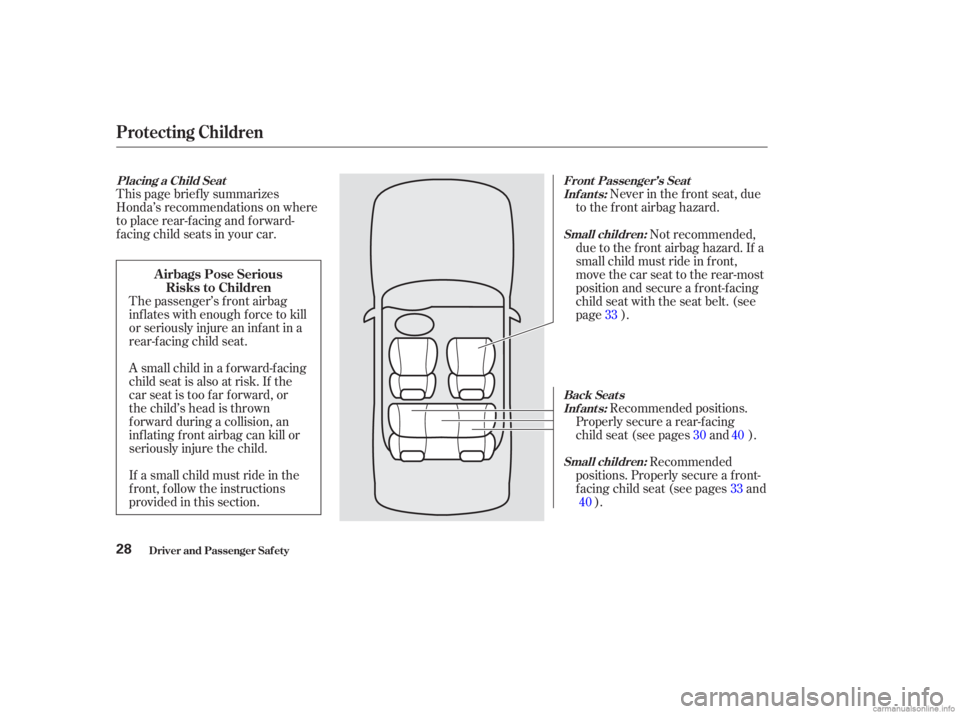
This page brief ly summarizes
Honda’s recommendations on where
to place rear-facing and forward-
f acing child seats in your car.Never in the f ront seat, due
to the f ront airbag hazard.
The passenger’s f ront airbag
inf lates with enough f orce to kill
or seriously injure an inf ant in a
rear-facing child seat.
If a small child must ride in the
f ront, f ollow the instructions
provided in this section. A small child in a f orward-f acing
child seat is also at risk. If the
carseatistoofarforward,or
the child’s head is thrown
f orward during a collision, an
inf lating f ront airbag can kill or
seriously injure the child. Recommended
positions. Properly secure a f ront-
f acing child seat (see pages and ).Recommended positions.
Properlysecurearear-facing
child seat (see pages and ). Not recommended,
due to the f ront airbag hazard. If a
small child must ride in f ront,
move the car seat to the rear-most
position and secure a f ront-f acing
child seat with the seat belt. (see
page ). 33
30 40
40 33
Placing a Child Seat
Front Passenger’s Seat
Inf ant s:
Back Seat sSmall children:
Inf ant s:
Small children:
Airbags Pose Serious
Risks to Children
Protecting Children
Driver and Passenger Saf ety28
Page 33 of 395
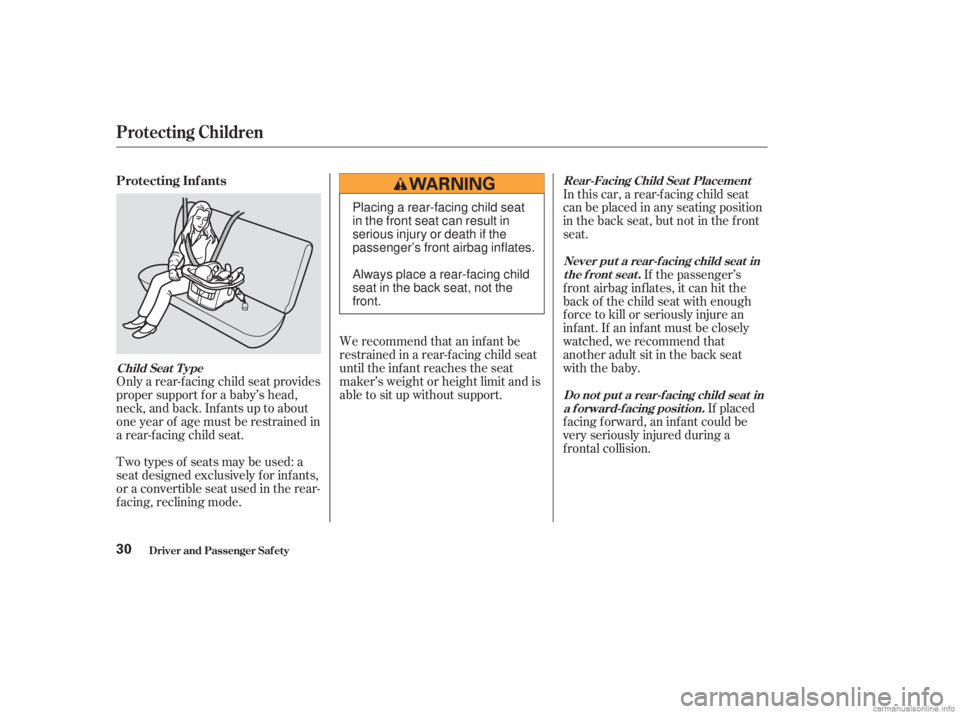
Only a rear-f acing child seat provides
proper support f or a baby’s head,
neck, and back. Inf ants up to about
one year of age must be restrained in
a rear-f acing child seat.In this car, a rear-f acing child seat
can be placed in any seating position
in the back seat, but not in the front
seat.
Two types of seats may be used: a
seat designed exclusively f or inf ants,
or a convertible seat used in the rear-
f acing, reclining mode. We recommend that an inf ant be
restrained in a rear-f acing child seat
until the inf ant reaches the seat
maker’s weight or height limit and is
able to sit up without support.
If the passenger’s
f ront airbag inf lates, it can hit the
back of the child seat with enough
f orce to kill or seriously injure an
inf ant. If an inf ant must be closely
watched, we recommend that
another adult sit in the back seat
with the baby.
If placed
f acing f orward, an inf ant could be
very seriously injured during a
f rontal collision.
Protecting Inf ants
Child Seat T ype
Rear-Facing Child Seat Placement
Never put a rear-f acing child seat inthe front seat.
Do not put a rear-f acing child seat ina f orward-f acing position.
Protecting Children
Driver and Passenger Saf ety30
Placing a rear-facing child seat
in the front seat can result in
serious injury or death if the
passenger’s front airbag inflates.
Always place a rear-facing child
seat in the back seat, not the
front.
Page 36 of 395
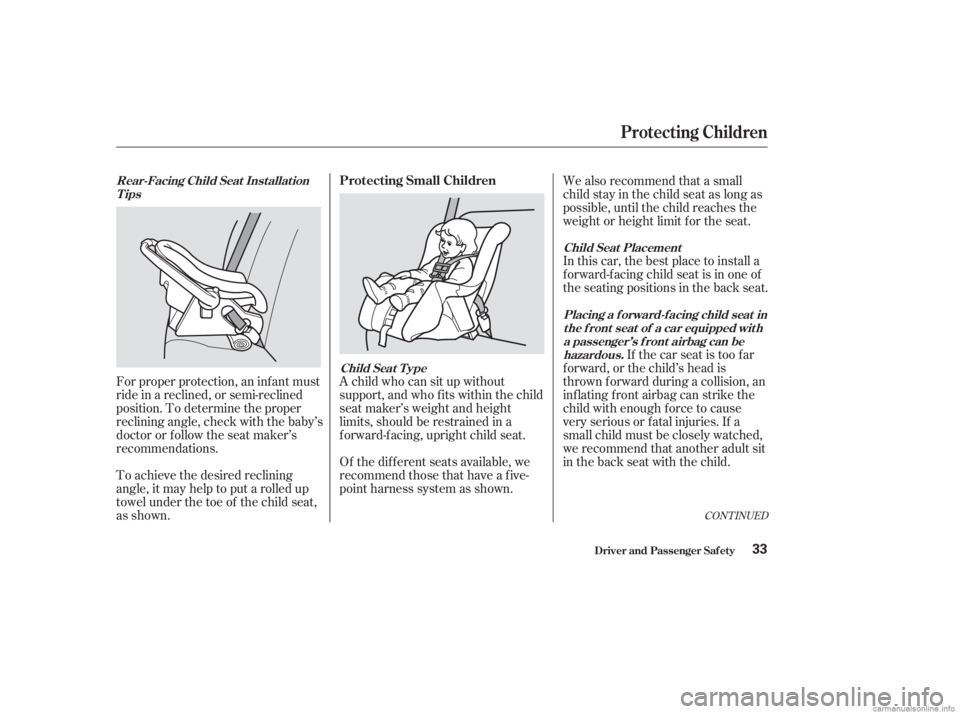
CONT INUED
To achieve the desired reclining
angle, it may help to put a rolled up
towel under the toe of the child seat,
as shown. Forproperprotection,aninfantmust
ride in a reclined, or semi-reclined
position. To determine the proper
reclining angle, check with the baby’s
doctor or f ollow the seat maker’s
recommendations.We also recommend that a small
child stay in the child seat as long as
possible, until the child reaches the
weight or height limit f or the seat.
In this car, the best place to install a
f orward-f acing child seat is in one of
the seating positions in the back seat.
A child who can sit up without
support, and who f its within the child
seat maker’s weight and height
limits, should be restrained in a
f orward-f acing, upright child seat.
Of the different seats available, we
recommend those that have a f ive-
point harness system as shown. If the car seat is too far
f orward, or the child’s head is
thrown f orward during a collision, an
inflating front airbag can strike the
child with enough f orce to cause
very serious or f atal injuries. If a
small child must be closely watched,
we recommend that another adult sit
in the back seat with the child.
Protecting Children
Driver and Passenger Saf ety
Rear-Facing Child Seat Inst allat ion
Tips
Child Seat Placement
Child Seat T ype Placing a f orward-f acing child seat in
t he f ront seat of a car equipped wit ha passenger’s f ront airbag can behazardous.Protecting Small Children
33
Page 37 of 395
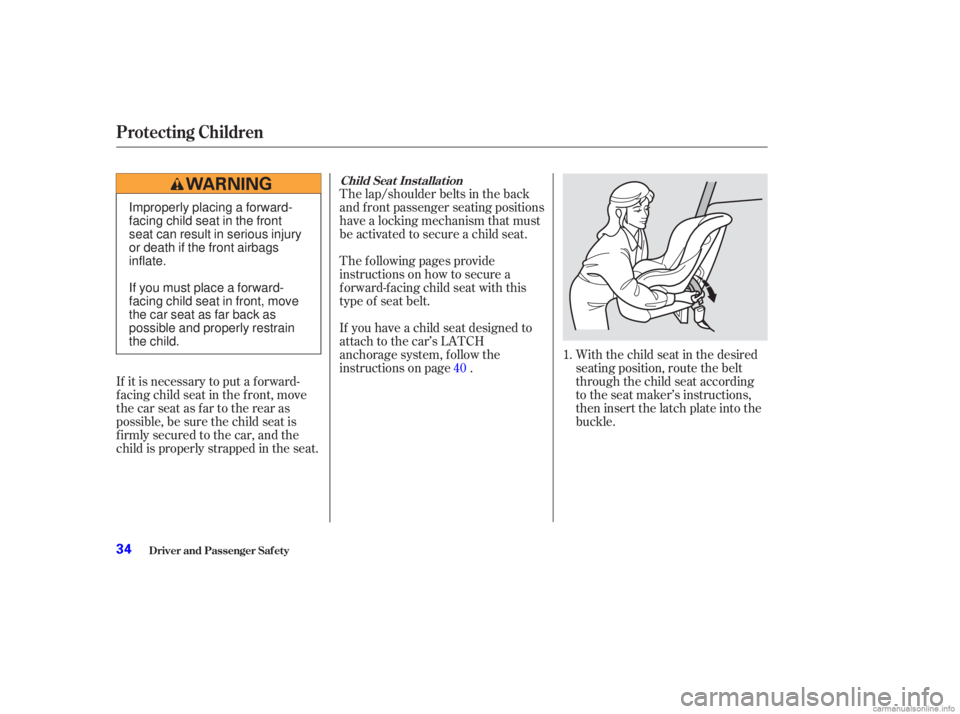
The lap/shoulder belts in the back
and f ront passenger seating positions
have a locking mechanism that must
be activated to secure a child seat.With the child seat in the desired
seating position, route the belt
through the child seat according
to the seat maker’s instructions,
then insert the latch plate into the
buckle.
The f ollowing pages provide
instructions on how to secure a
f orward-f acing child seat with this
type of seat belt.
If it is necessary to put a f orward-
f acing child seat in the f ront, move
the car seat as far to the rear as
possible, be sure the child seat is
f irmly secured to the car, and the
child is properly strapped in the seat. If you have a child seat designed to
attach to the car’s LATCH
anchorage system, follow the
instructions on page .
1.
40
Child Seat Inst allat ion
Protecting Children
Driver and Passenger Saf ety34
Improperly placing a forward-
facing child seat in the front
seat can result in serious injury
or death if the front airbags
inflate.
Ifyoumustplaceaforward-
facing child seat in front, move
the car seat as far back as
possible and properly restrain
the child.
Page 39 of 395
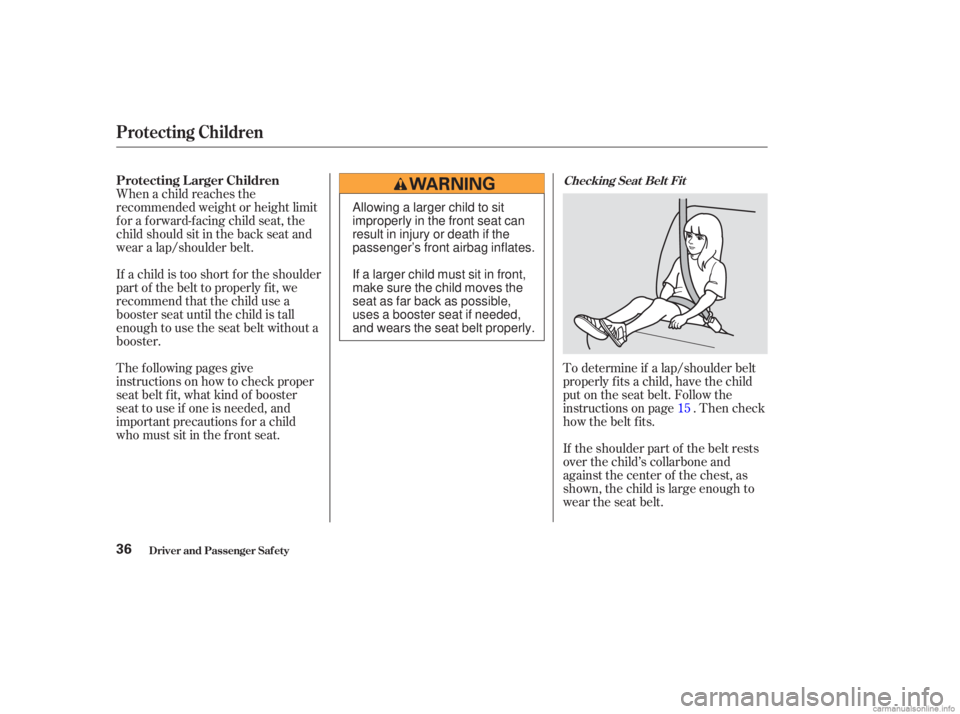
When a child reaches the
recommended weight or height limit
for a forward-facing child seat, the
child should sit in the back seat and
wear a lap/shoulder belt.
If a child is too short f or the shoulder
part of the belt to properly f it, we
recommend that the child use a
booster seat until the child is tall
enough to use the seat belt without a
booster.
The f ollowing pages give
instructions on how to check proper
seat belt f it, what kind of booster
seat to use if one is needed, and
important precautions f or a child
who must sit in the f ront seat.To determine if a lap/shoulder belt
properly f its a child, have the child
put on the seat belt. Follow the
instructions on page . Then check
how the belt f its.
If the shoulder part of the belt rests
over the child’s collarbone and
against the center of the chest, as
shown, the child is large enough to
wear the seat belt.15
Checking Seat Belt Fit
Protecting Children
Driver and Passenger Saf ety
Protecting L arger Children
36
Allowing a larger child to sit
improperly in the front seat can
result in injury or death if the
passenger’s front airbag inflates.
If a larger child must sit in front,
make sure the child moves the
seat as far back as possible,
uses a booster seat if needed,
and wears the seat belt properly.
Page 41 of 395
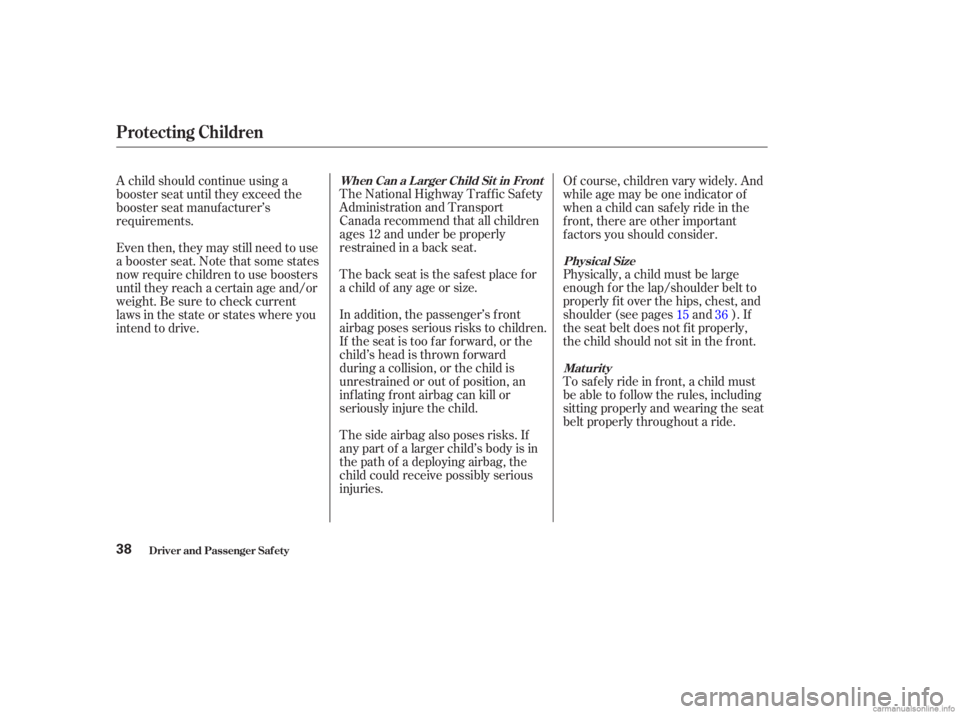
The National Highway Traffic Safety
Administration and Transport
Canada recommend that all children
ages 12 and under be properly
restrained in a back seat.
The back seat is the saf est place f or
a child of any age or size.Physically, a child must be large
enough f or the lap/shoulder belt to
properly f it over the hips, chest, and
shoulder (see pages and ). If
the seat belt does not f it properly,
the child should not sit in the f ront.
To saf ely ride in f ront, a child must
be able to f ollow the rules, including
sitting properly and wearing the seat
belt properly throughout a ride. Of course, children vary widely. And
while age may be one indicator of
when a child can saf ely ride in the
f ront, there are other important
f actors you should consider.
In addition, the passenger’s f ront
airbag poses serious risks to children.
If the seat is too f ar f orward, or the
child’s head is thrown f orward
during a collision, or the child is
unrestrained or out of position, an
inf lating f ront airbag can kill or
seriously injure the child.
The side airbag also poses risks. If
any part of a larger child’s body is in
the path of a deploying airbag, the
child could receive possibly serious
injuries.
A child should continue using a
booster seat until they exceed the
booster seat manuf acturer’s
requirements.
Even then, they may still need to use
a booster seat. Note that some states
now require children to use boosters
until they reach a certain age and/or
weight.Besuretocheckcurrent
laws in the state or states where you
intend to drive.
3615
Driver and Passenger Saf ety
Protecting Children
When Can a Larger Child Sit in Front
Maturity
Physical Size
38
Page 42 of 395
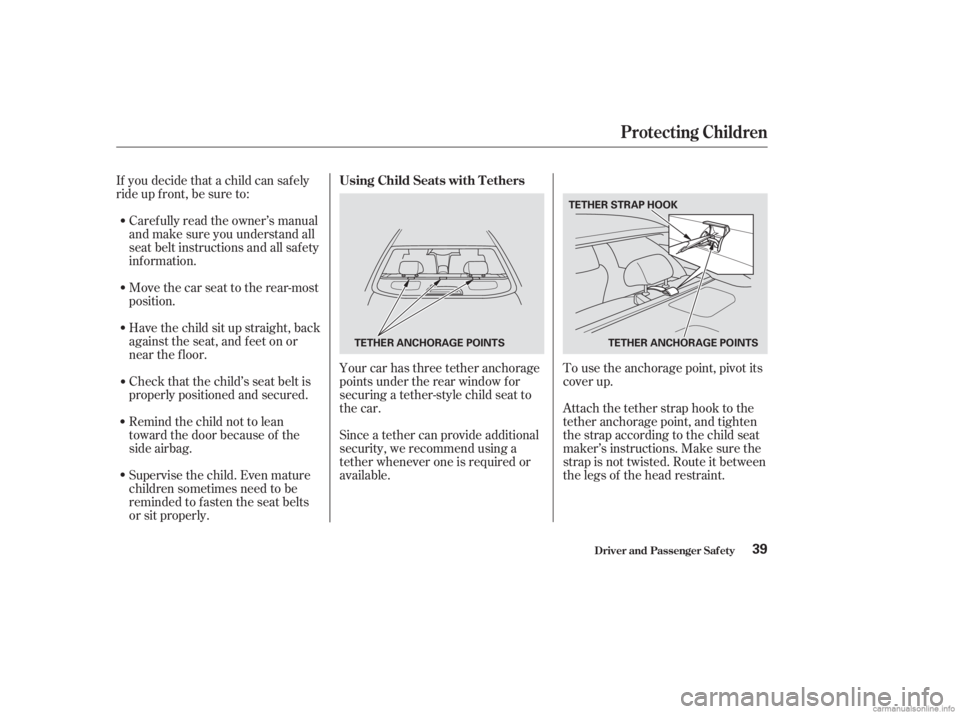
If you decide that a child can saf ely
ride up f ront, be sure to:Caref ully read the owner’s manual
and make sure you understand all
seat belt instructions and all saf ety
inf ormation.
Have the child sit up straight, back
against the seat, and feet on or
near the f loor. Move the car seat to the rear-most
position.
Remind the child not to lean
toward the door because of the
side airbag. Check that the child’s seat belt is
properly positioned and secured.
Supervise the child. Even mature
children sometimes need to be
reminded to f asten the seat belts
or sit properly. Your car has three tether anchorage
points under the rear window f or
securing a tether-style child seat to
the car.
Since a tether can provide additional
security, we recommend using a
tether whenever one is required or
available.
To use the anchorage point, pivot its
cover up.
Attach the tether strap hook to the
tether anchorage point, and tighten
the strap according to the child seat
maker’s instructions. Make sure the
strap is not twisted. Route it between
the legs of the head restraint.
Protecting Children
Driver and Passenger Saf ety
Using Child Seats with T ethers
39
TETHER STRAP HOOK
TETHER ANCHORAGE POINTS
TETHER ANCHORAGE POINTS
Page 46 of 395
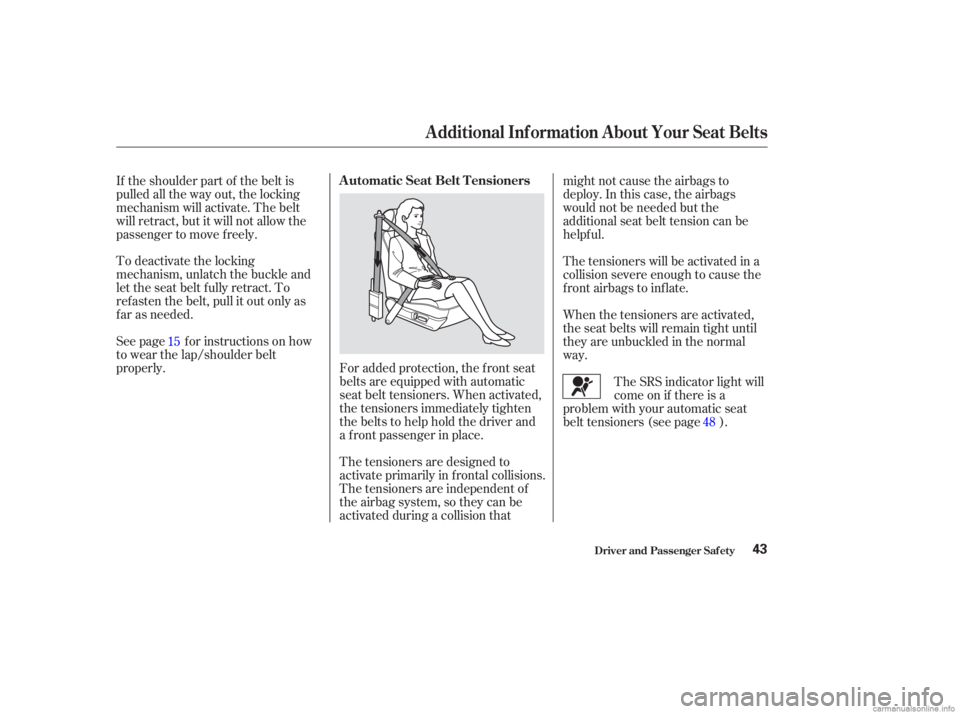
See page f or instructions on how
to wear the lap/shoulder belt
properly. To deactivate the locking
mechanism, unlatch the buckle and
let the seat belt f ully retract. To
ref asten the belt, pull it out only as
f ar as needed. If the shoulder part of the belt is
pulled all the way out, the locking
mechanism will activate. The belt
will retract, but it will not allow the
passenger to move f reely.For added protection, the f ront seat
belts are equipped with automatic
seat belt tensioners. When activated,
the tensioners immediately tighten
the belts to help hold the driver and
a f ront passenger in place.
The tensioners are designed to
activate primarily in f rontal collisions.
The tensioners are independent of
the airbag system, so they can be
activated during a collision thatmight not cause the airbags to
deploy. In this case, the airbags
would not be needed but the
additional seat belt tension can be
helpf ul.
The tensioners will be activated in a
collision severe enough to cause the
f ront airbags to inf late.
When the tensioners are activated,
the seat belts will remain tight until
they are unbuckled in the normal
way.
The SRS indicator light will
come on if there is a
problem with your automatic seat
belt tensioners (see page ).
15
48
Additional Inf ormation About Your Seat Belts
Driver and Passenger Saf ety
A utomatic Seat Belt T ensioners
43